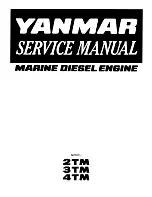
Landa SLT/SLX • Gas 8.914-002.0 • Rev. 4/13
OPERA
TOR’S MANU
AL
PRESSURE
W
ASHER
14
Step 4 After circulating solution, flush the entire
system with fresh water. Clean out float
tank and then reinstall wand assembly to
spray gun.
Removal of Soot and Heating Coil
In the heating process, fuel residue in the form of
soot deposits may develop on the heating coil pipe
and block air flow which will affect burner combustion.
When soot has been detected on visual observation,
the soot on the coil must be washed off after following
the coil removal steps (See Coil Removal–page 16).
Pressure Relief Valve
Each machine is equipped with a relief valve to relieve
pressure in the system when higher than normal op-
erating pressures are encountered or if the unloader
valve should fail. Unusually high pressures come
from an object plugging the spray nozzle. If operating
pressure is found to be normal and the relief valve
continues to leak, repair or replace valve.
CAUTION:
This valve must be opened each year to check op-
eration.
Rupture Disk
If pressure from pump or thermal expansion should
exceed safe limits, the rupture disk will burst, allow-
ing high pressure to be discharged through hose to
ground. The ruptured disk needs to be inspected once
or twice a year for any obstructions.
Fuel
Use clean fuel oil that is not contaminated with water
and debris. Replace fuel filter and drain tank every 100
hours of operation.
Use No. 1 or No. 2 heating oil (ASTM D306) only.
NEVER
use gasoline in your burner fuel tank. Gasoline
is more combustible than fuel oil and could result in
a serious explosion.
NEVER
use crankcase or waste
oil in your burner. Fuel unit malfunction could result
from contamination.
Fuel Control System
This machine utilizes a fuel solenoid valve located
on the fuel pump to control the flow of fuel to the
combustion chamber. The solenoid, which is normally
closed, is activated by a flow switch when water flows
through it. When the operator releases the trigger
on the spray gun, the flow of water through the flow
switch stops, turning off the electrical current to the
fuel solenoid.
The solenoid then closes, shutting off the supply of
fuel to the combustion chamber. Controlling the flow
of fuel in this way gives an instantaneous burn-or-
no-burn situation, thereby eliminating high and low
MAINTENANCE & SERVICE
water temperatures, and combustion smoke normally
associated with machines incorporating a spray gun.
CAUTION: Periodic inspection, to insure that the
fuel solenoid valve functions properly, is recom-
mended. This can be done by operating the ma-
chine and checking to see that the burner is not
firing when the spray gun is in the off position.
Fuel Pressure Adjustment
To control water temperature, adjust fuel pressure
by turning the regulating pressure adjusting screw
clockwise to increase, counterclockwise to decrease.
Do not exceed 200 psi.
NOTE:
When changing fuel
pump, a bypass plug must be installed in return port
or fuel pump will not prime.
Burner Nozzle
Keep the tip free of surface deposits by wiping it with
a clean, solvent-saturated cloth, being careful not to
plug or enlarge the nozzle. For maximum efficiency,
replace the nozzle each season.
Burner Air Adjustment:
The oil burner on this machine is preset for operation
at altitudes below 1000 feet. If operated at higher
altitudes, it may be necessary to adjust the air band
setting. Adjust air band for a #1 or #2 smoke spot
on the Bacharach scale. If a smoky or eye-burning
exhaust is being emitted from the stack, two things
should be checked. First, check the fuel to be certain
that kerosene or No.1 home heating fuel is being used.
Next, check the air adjustment on the burner. An oily,
smoky fire indicates a lack of air and the air band
should be moved to allow the air to flow through the
burner. Sharp eye-burning fumes indicate too much
air flowing through the combustion chamber. The air
band should be readjusted to allow less air to flow
through the burner.
CAUTION: If white smoke appears from burner
exhaust vent during start-up or operation, discon-
tinue use and readjust air bands.
NOTE: If a flue is installed, have a professional ser-
viceman adjust your burner for a #1 or #2 smoke
spot on the Bacharach scale.
5/32" Gap
1/16"
Nozzle
Electrode
7/16"















































